Robotic Vacuum Cleaner Comparison: The Future of Home Cleaning
In the last few years, robotic vacuum cleaners have transformed the way we keep cleanliness in our homes. With improvements in innovation and the incorporation of artificial intelligence, these gadgets have progressed from mere novelty products to essential home appliances. This short article supplies an extensive comparison of a few of the leading robotic vacuum cleaners on the market, assisting consumers make informed decisions when choosing a design that suits their needs.
Comprehending Robotic Vacuum Cleaners
Robotic vacuum are self-governing devices designed to clean floorings immediately. Geared up with sensors, they browse around challenges and adjust their cleaning routes for optimal effectiveness. The key functions that differentiate different designs include suction power, battery life, app connectivity, navigation technology, and price.
Key Features to Consider
When comparing robotic vacuum, potential buyers ought to take into consideration the following elements:
- Suction Power: Measured in Pascals (Pa), suction power figures out the efficiency of getting dirt and particles.
- Battery Life: The length of time a vacuum can operate before requiring a recharge considerably affects its cleaning efficiency.
- Navigation Technology: Models may utilize simple random navigation or sophisticated mapping innovations (like LIDAR) that enable them to create a map of the home.
- Smart Features: Connectivity to smartphone apps or smart home systems can boost functionality and control.
- Filter Type: HEPA filters are recommended for allergic reaction patients, as they trap allergens and enhance air quality.
Comparison of Top Robotic Vacuum Cleaners
Below is a comparison table of a few of the best robotic vacuum cleaners offered in 2023:
| Model | Suction Power (Pa) | Battery Life (min) | Navigation Technology | Smart Features | Price (GBP) |
|---|---|---|---|---|---|
| iRobot Roomba i7+ | 1700 | 75 | Smart mapping | App control, voice command | ₤ 949 |
| Roborock S7 | 2500 | 180 | LIDAR | App control, multi-floor | ₤ 649 |
| Neato D7 | 2000 | 120 | LIDAR | App control, zone cleaning | ₤ 599 |
| Ecovacs Deebot T10 | 3000 | 150 | Smart mapping | App control, room detection | ₤ 799 |
| Shark IQ Robot | 1200 | 90 | Random | App control, self-emptying | ₤ 399 |
Description of the Table
- iRobot Roomba i7+: Known for its robust cleaning capability, it features smart mapping technology that allows it to designate specific areas for cleaning. Its self-emptying feature is a plus for convenience.
- Roborock S7: This design masters suction power and battery life, making it perfect for bigger homes. Its LIDAR technology helps create an efficient cleaning path, and it can vacuum and mop all at once.
- Neato D7: The D-shape design permits for much better corner cleaning, and it includes strong suction power. Its LIDAR navigation allows it to draw up cleaning areas precisely.
- Ecovacs Deebot T10: Boasting the highest suction power and advanced navigation, this design can manage multiple floorings efficiently. It's a flexible option for homes with differing floor types.
- Shark IQ Robot: An affordable option that still uses smart features. Its self-emptying capability and app combination make it a practical option for those looking for a solid cleaning companion without breaking the bank.
Benefits of Robotic Vacuum Cleaners
Robotic vacuum cleaners use many advantages that add to their rising popularity among customers:
- Time-Saving: Automated cleaning enables users to maximize valuable time that can be invested in other activities.
- Convenience: Many models can be set up via apps to clean at specific times, minimizing manual effort.
- Ease of access: They can reach under furniture and in tight areas where traditional vacuums may have a hard time.
- Daily Maintenance: Regular use of robotic vacuums can help preserve a regularly tidy environment, promoting better overall home hygiene.
FAQs About Robotic Vacuum Cleaners
1. How frequently should I run my robotic vacuum?
It is recommended to run the robotic vacuum at least 2-3 times a week to preserve tidiness, though everyday use can be helpful, particularly in homes with pets or high foot traffic.
2. Do robotic vacuums deal with carpets?
Yes, numerous robotic vacuums are developed to deal with carpets, however efficiency may differ based upon the model's suction power and brush type. Try to find models specifically mentioned as reliable for carpets.
3. Can robotic vacuums tidy family pet hair?
A lot of robotic vacuums can efficiently pick up pet hair, but those with strong suction and tangle-free brush designs are particularly well-suited for this task.
4. How do I maintain my robotic vacuum?
Regular upkeep includes cleaning the brushes and sensors, clearing the dustbin, and periodically changing filters to ensure optimal efficiency.
5. Are best budget robot vacuum ?
While they tend to be more expensive than conventional vacuums, the convenience, effectiveness, and time-saving elements make them a deserving investment for lots of households.
The market for robotic vacuum cleaners continues to expand as innovation develops, offering customers a variety of options to match various cleaning requirements and spending plans. By carefully considering features such as suction power, battery life, and smart capabilities, users can pick a design that aligns with their lifestyle. Whether for benefit, ease of usage, or remarkable cleaning efficiency, robotic vacuums are certainly reshaping the future of home cleaning.

